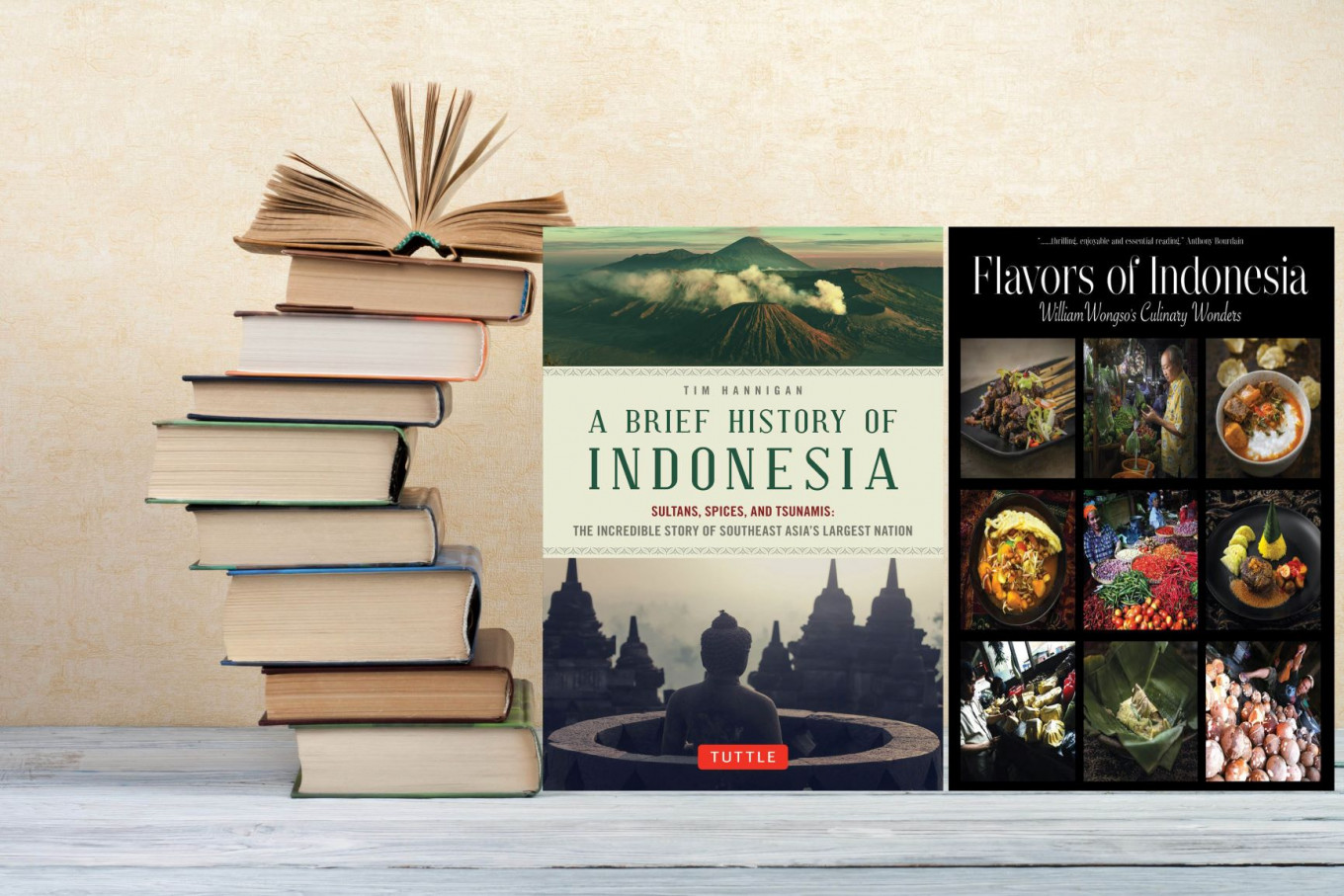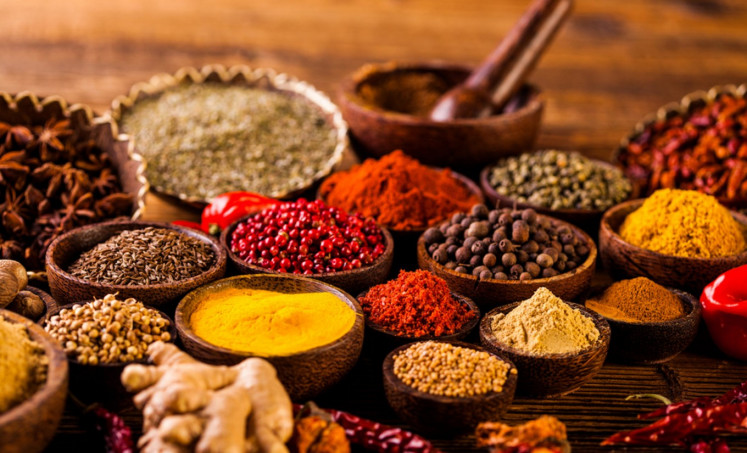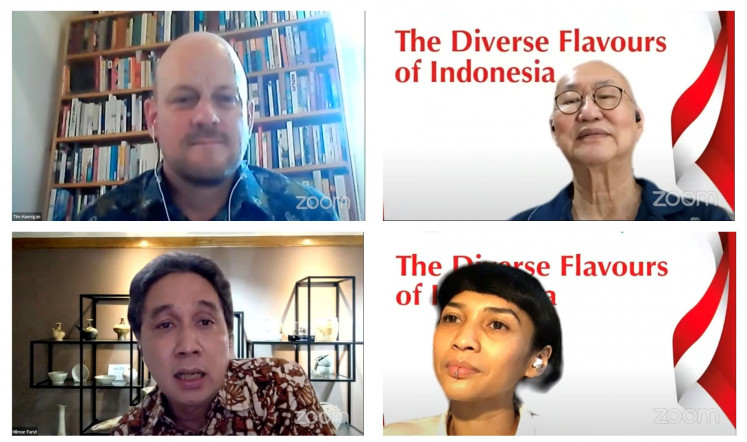Popular Reads
Top Results
Can't find what you're looking for?
View all search resultsPopular Reads
Top Results
Can't find what you're looking for?
View all search resultsRemapping the spice route: Understanding the history of Indonesian flavors
Indonesia is undoubtedly rich in its food culture and history, with 17,508 islands and over 300 ethnic groups making up the nation.
Change text size
Gift Premium Articles
to Anyone
The diversity of local cuisine and spices across Indonesia has given rise to an array of unique flavors.
However, the notion of spice trade purely as a product of colonialism is still rampant – with memories of the spice route poisoned with violent confrontations.
The Education and Culture Ministry's director general of culture, Hilmar Farid, said that spices played a very significant role not only in Indonesian cuisine but in the country’s history.
Hilmar, a speaker in an online discussion titled “The Diverse Flavors of Indonesia”, organized by the Periplus bookstore chain, said the government began an initiative to “rebuild” the spice route four years ago.
“Bringing this up, many have asked, why are we talking about the spice route? We are not celebrating colonialism. Because when we discuss spices right now, we talk about losses,” he said. “It is important to remember that spices existed before colonialism.”
Hilmar said insights, experiences, feelings and thoughts on the topic had been passed down from generation to generation, over hundreds and thousands of years.
“The sad story is that much of what we have is lost. Many expressions are now unknown. I am faced with [culinary] maestros that don’t have successors,” he said.
The Austronesian diaspora, he said, far preceded the colonization of Indonesia, dating back thousands of years to Graeco-Roman times, a feat only possible through connections.
Hilmar said the topic of colonialism should not be ignored because of the bitter memories. “We have to find a way to face this painful past and sublimate it. Our suffering, bitter experiences, stories of losses should become something useful,” he said.
Hot stuff: Indonesia has been known throughout history for its plethora of spices. (Courtesy of Shutterstock/-)The Indonesian archipelago has been known throughout history for its wealth of spices, from nutmegs, cloves and ginger to pepper and cinnamon, brought to the world by its sailors.
Their healing properties, distinctive tastes and aromas, as well as other benefits, are the main reasons the spices have been sought after worldwide. Trading routes to and from Indonesia’s Spice Islands are known by many names, such as the Spice Trail, the Spice Route or the Maritime Silk Road.
Earlier in March, Hilmar revealed that his office and Negeri Rempah Foundation would collect historical data to support the government’s effort to get the great story of the spice trade recognized by the UNESCO World Heritage Committee.
The idea of having world recognition for the spice route was initiated by The Jakarta Post’s Indonesian Museum Foundation in 2015. In collaboration with other media companies and a production house, there was an expedition to spice suppliers of Indonesia.
Understanding on the importance of connections in Indonesian culinary history was further highlighted by British journalist and author Tim Hannigan, another speaker at the event.
Cuisine, he argues, is the result of connections formed through trade and assimilation between countries and diverse groups.
“In every part of the world, you cannot have entirely local food. You cannot have food without outside influences […] Food is an international thing, try to imagine Indonesian food without chili and nuts – they are also from South America, brought to Indonesia by Portugal – every cuisine is international,” Hannigan said.
Food for thought: Periplus hosts a virtual discussion on Indonesia’s diverse flavors, featuring three speakers: author Tim Hannigan (top left), culinary expert William Wongso (top right) and Education and Culture Ministry director general of culture Hilmar Farid (bottom left). It was moderated by food writer Ade Putri Paramadita. (Courtesy of Periplus/-)Indonesian culinary expert William Wongso reflected on culinary diversity and the concept of Indonesian flavor profiles in food.
“There is no such thing as Indonesian food, only regional cooking, since Indonesia has no [dishes consistently appearing throughout all regions]. Indonesia is the most diverse culinary heritage, region by region.”
Wongso has also been instrumental in the fight to rebuild the spice route. His Spice Up The World initiative introduces Indonesian cuisine to different countries.
He said Indonesian restaurants tended to not fare well abroad due to a difference in palate, pushing him to emphasize the importance of “food culture” and adapting Indonesian ingredients to different local flavors.
“We have to understand our food not through taste, but food culture. If we introduce food culture [to foreigners], they will become much more absorbed […] Otherwise it’ll be between like or dislike.”
Through fusing raw ingredients, or recreating a specific dish, Wongso has assimilated Indonesian spices into the context of the local culinary scene. Through this fusion cooking, taste buds are primed for Indonesian food without alienating people that are unfamiliar with it.
Hannigan also pushed for greater awareness for travelers to help in preserving traditional dishes by embracing diversity of flavors in Indonesian cooking.
“People from outside, traveling, have an input to protect local cuisines. If you look for the same things in every place [you visit], then why would people sell the local food?”
Hannigan also spoke about the etymological nature of dating food, a technique that is not accurate, but may provide historians with a vague idea about how to go about tracing culinary origins.
“The history [of flavors] is not written, it is in our language. It’s the history that’s not in books, it’s the history that’s in our mouths – in words and in flavors.”
Wongso is hopeful for the future, however, saying that with social media, people are more interested in tasting a wider variety of cuisines.
“You can Google anything, but you can’t Google taste,” he said. (ste)
-- The writer is an intern at The Jakarta Post.












